Analyzing Professional Communication Skills: Price, Demand, Supply
VerifiedAdded on 2019/11/08
|8
|2084
|389
Essay
AI Summary
This essay explores the dynamics of professional communication skills, focusing on the interplay between price, demand, and supply within an economic context. It examines how factors such as consumer behavior, market equilibrium, and price elasticity influence the success of businesses. The essay references economic theories and real-world examples, including the impact of price changes on consumer purchasing decisions and the importance of understanding market forces. It discusses the roles of supply and demand in determining prices, emphasizing the significance of market equilibrium for sustained profitability. The essay also touches on the impact of economic factors like recession on consumer purchasing power and how businesses can adapt to changing market conditions. The discussion includes references to relevant articles and studies, providing a comprehensive overview of the topic.
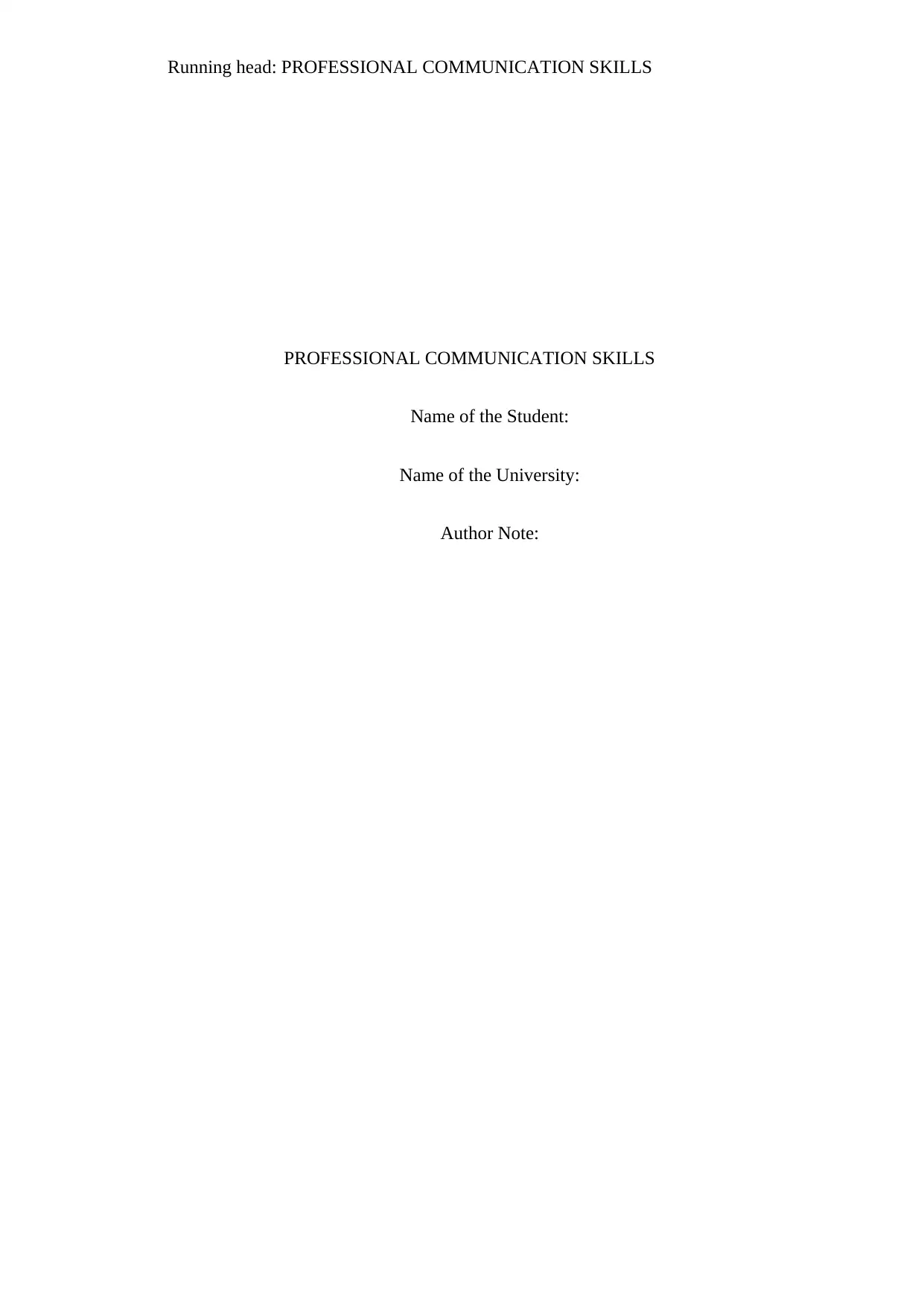
Running head: PROFESSIONAL COMMUNICATION SKILLS
PROFESSIONAL COMMUNICATION SKILLS
Name of the Student:
Name of the University:
Author Note:
PROFESSIONAL COMMUNICATION SKILLS
Name of the Student:
Name of the University:
Author Note:
Paraphrase This Document
Need a fresh take? Get an instant paraphrase of this document with our AI Paraphraser
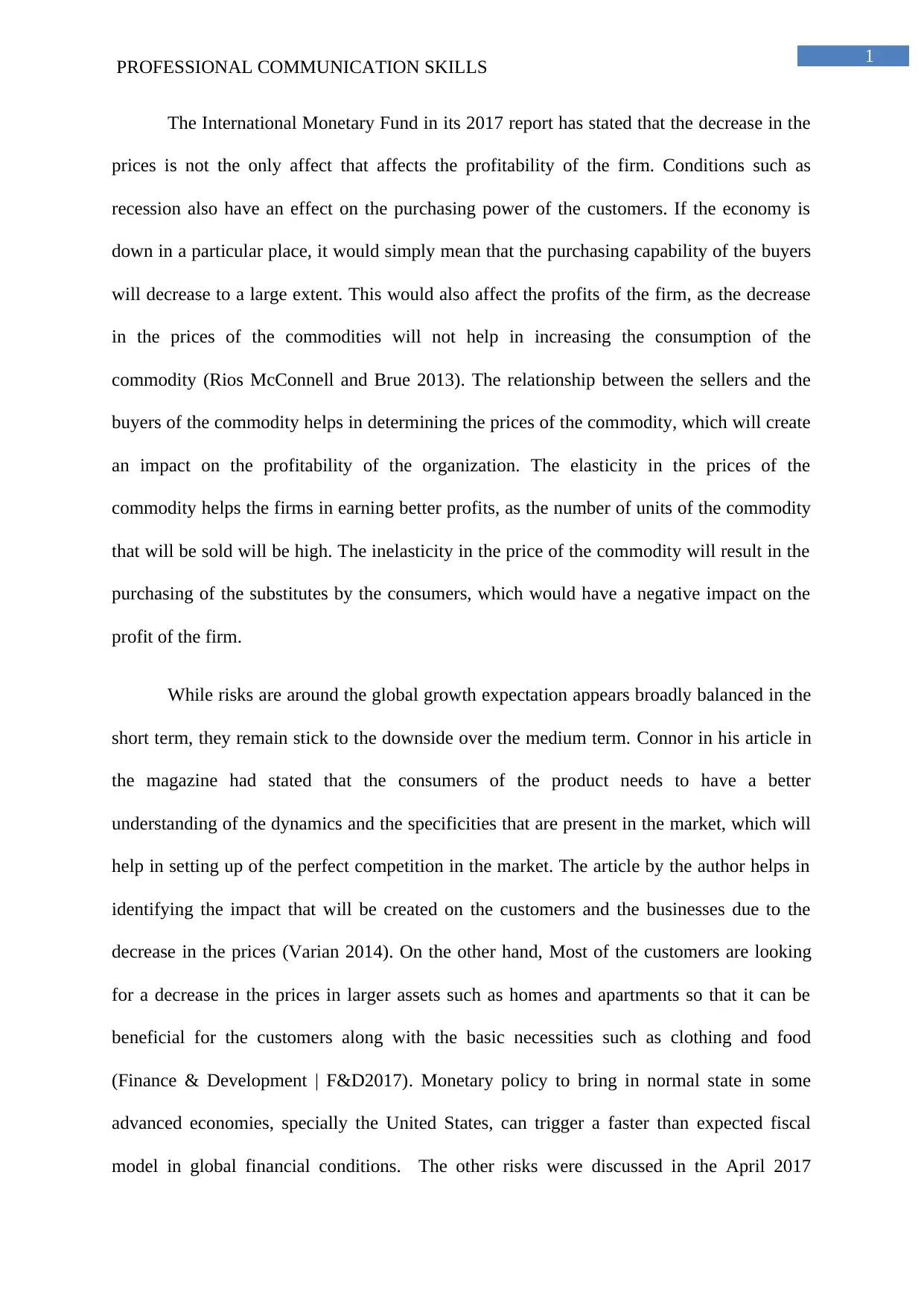
1
PROFESSIONAL COMMUNICATION SKILLS
The International Monetary Fund in its 2017 report has stated that the decrease in the
prices is not the only affect that affects the profitability of the firm. Conditions such as
recession also have an effect on the purchasing power of the customers. If the economy is
down in a particular place, it would simply mean that the purchasing capability of the buyers
will decrease to a large extent. This would also affect the profits of the firm, as the decrease
in the prices of the commodities will not help in increasing the consumption of the
commodity (Rios McConnell and Brue 2013). The relationship between the sellers and the
buyers of the commodity helps in determining the prices of the commodity, which will create
an impact on the profitability of the organization. The elasticity in the prices of the
commodity helps the firms in earning better profits, as the number of units of the commodity
that will be sold will be high. The inelasticity in the price of the commodity will result in the
purchasing of the substitutes by the consumers, which would have a negative impact on the
profit of the firm.
While risks are around the global growth expectation appears broadly balanced in the
short term, they remain stick to the downside over the medium term. Connor in his article in
the magazine had stated that the consumers of the product needs to have a better
understanding of the dynamics and the specificities that are present in the market, which will
help in setting up of the perfect competition in the market. The article by the author helps in
identifying the impact that will be created on the customers and the businesses due to the
decrease in the prices (Varian 2014). On the other hand, Most of the customers are looking
for a decrease in the prices in larger assets such as homes and apartments so that it can be
beneficial for the customers along with the basic necessities such as clothing and food
(Finance & Development | F&D2017). Monetary policy to bring in normal state in some
advanced economies, specially the United States, can trigger a faster than expected fiscal
model in global financial conditions. The other risks were discussed in the April 2017
PROFESSIONAL COMMUNICATION SKILLS
The International Monetary Fund in its 2017 report has stated that the decrease in the
prices is not the only affect that affects the profitability of the firm. Conditions such as
recession also have an effect on the purchasing power of the customers. If the economy is
down in a particular place, it would simply mean that the purchasing capability of the buyers
will decrease to a large extent. This would also affect the profits of the firm, as the decrease
in the prices of the commodities will not help in increasing the consumption of the
commodity (Rios McConnell and Brue 2013). The relationship between the sellers and the
buyers of the commodity helps in determining the prices of the commodity, which will create
an impact on the profitability of the organization. The elasticity in the prices of the
commodity helps the firms in earning better profits, as the number of units of the commodity
that will be sold will be high. The inelasticity in the price of the commodity will result in the
purchasing of the substitutes by the consumers, which would have a negative impact on the
profit of the firm.
While risks are around the global growth expectation appears broadly balanced in the
short term, they remain stick to the downside over the medium term. Connor in his article in
the magazine had stated that the consumers of the product needs to have a better
understanding of the dynamics and the specificities that are present in the market, which will
help in setting up of the perfect competition in the market. The article by the author helps in
identifying the impact that will be created on the customers and the businesses due to the
decrease in the prices (Varian 2014). On the other hand, Most of the customers are looking
for a decrease in the prices in larger assets such as homes and apartments so that it can be
beneficial for the customers along with the basic necessities such as clothing and food
(Finance & Development | F&D2017). Monetary policy to bring in normal state in some
advanced economies, specially the United States, can trigger a faster than expected fiscal
model in global financial conditions. The other risks were discussed in the April 2017
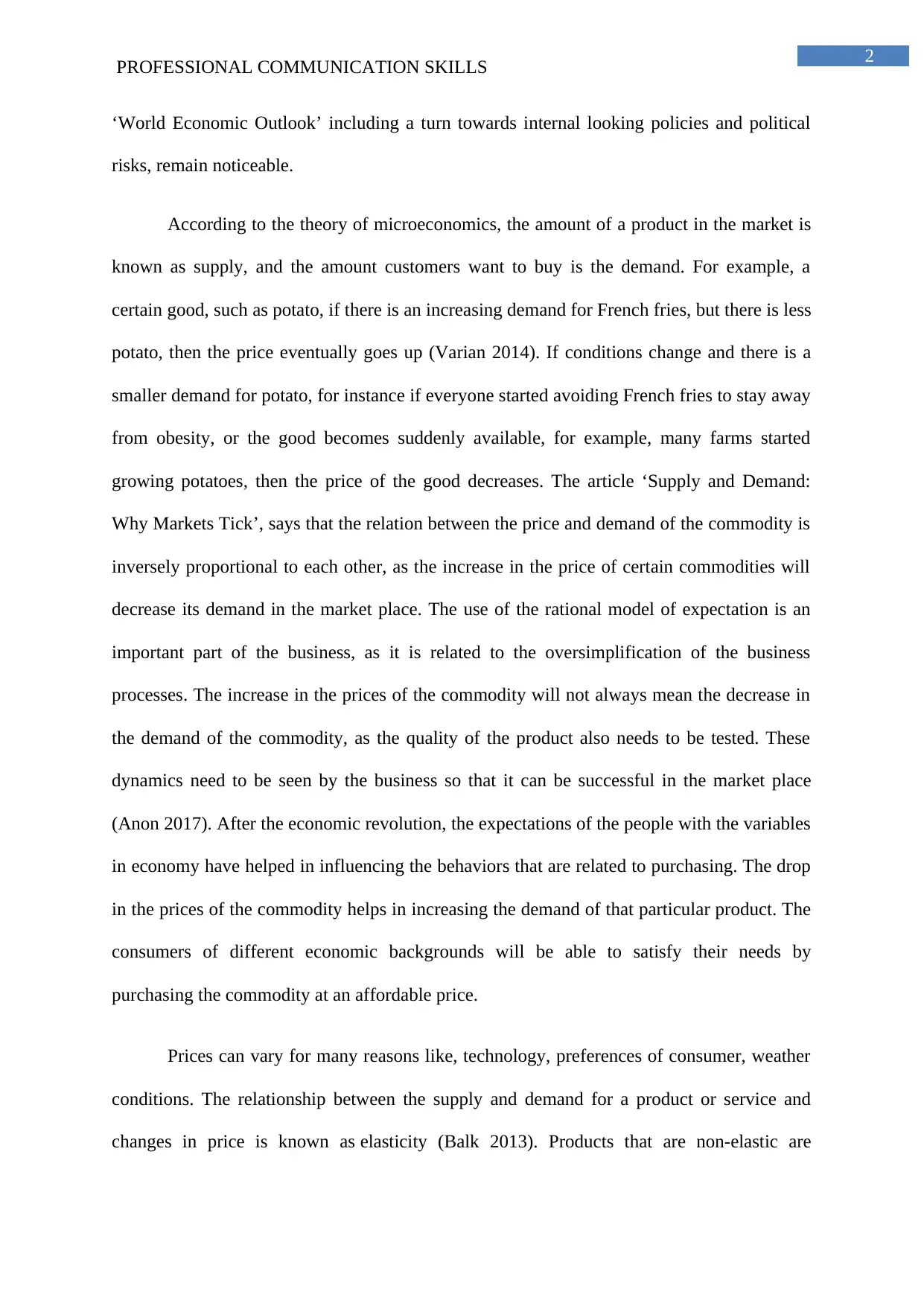
2
PROFESSIONAL COMMUNICATION SKILLS
‘World Economic Outlook’ including a turn towards internal looking policies and political
risks, remain noticeable.
According to the theory of microeconomics, the amount of a product in the market is
known as supply, and the amount customers want to buy is the demand. For example, a
certain good, such as potato, if there is an increasing demand for French fries, but there is less
potato, then the price eventually goes up (Varian 2014). If conditions change and there is a
smaller demand for potato, for instance if everyone started avoiding French fries to stay away
from obesity, or the good becomes suddenly available, for example, many farms started
growing potatoes, then the price of the good decreases. The article ‘Supply and Demand:
Why Markets Tick’, says that the relation between the price and demand of the commodity is
inversely proportional to each other, as the increase in the price of certain commodities will
decrease its demand in the market place. The use of the rational model of expectation is an
important part of the business, as it is related to the oversimplification of the business
processes. The increase in the prices of the commodity will not always mean the decrease in
the demand of the commodity, as the quality of the product also needs to be tested. These
dynamics need to be seen by the business so that it can be successful in the market place
(Anon 2017). After the economic revolution, the expectations of the people with the variables
in economy have helped in influencing the behaviors that are related to purchasing. The drop
in the prices of the commodity helps in increasing the demand of that particular product. The
consumers of different economic backgrounds will be able to satisfy their needs by
purchasing the commodity at an affordable price.
Prices can vary for many reasons like, technology, preferences of consumer, weather
conditions. The relationship between the supply and demand for a product or service and
changes in price is known as elasticity (Balk 2013). Products that are non-elastic are
PROFESSIONAL COMMUNICATION SKILLS
‘World Economic Outlook’ including a turn towards internal looking policies and political
risks, remain noticeable.
According to the theory of microeconomics, the amount of a product in the market is
known as supply, and the amount customers want to buy is the demand. For example, a
certain good, such as potato, if there is an increasing demand for French fries, but there is less
potato, then the price eventually goes up (Varian 2014). If conditions change and there is a
smaller demand for potato, for instance if everyone started avoiding French fries to stay away
from obesity, or the good becomes suddenly available, for example, many farms started
growing potatoes, then the price of the good decreases. The article ‘Supply and Demand:
Why Markets Tick’, says that the relation between the price and demand of the commodity is
inversely proportional to each other, as the increase in the price of certain commodities will
decrease its demand in the market place. The use of the rational model of expectation is an
important part of the business, as it is related to the oversimplification of the business
processes. The increase in the prices of the commodity will not always mean the decrease in
the demand of the commodity, as the quality of the product also needs to be tested. These
dynamics need to be seen by the business so that it can be successful in the market place
(Anon 2017). After the economic revolution, the expectations of the people with the variables
in economy have helped in influencing the behaviors that are related to purchasing. The drop
in the prices of the commodity helps in increasing the demand of that particular product. The
consumers of different economic backgrounds will be able to satisfy their needs by
purchasing the commodity at an affordable price.
Prices can vary for many reasons like, technology, preferences of consumer, weather
conditions. The relationship between the supply and demand for a product or service and
changes in price is known as elasticity (Balk 2013). Products that are non-elastic are
⊘ This is a preview!⊘
Do you want full access?
Subscribe today to unlock all pages.

Trusted by 1+ million students worldwide
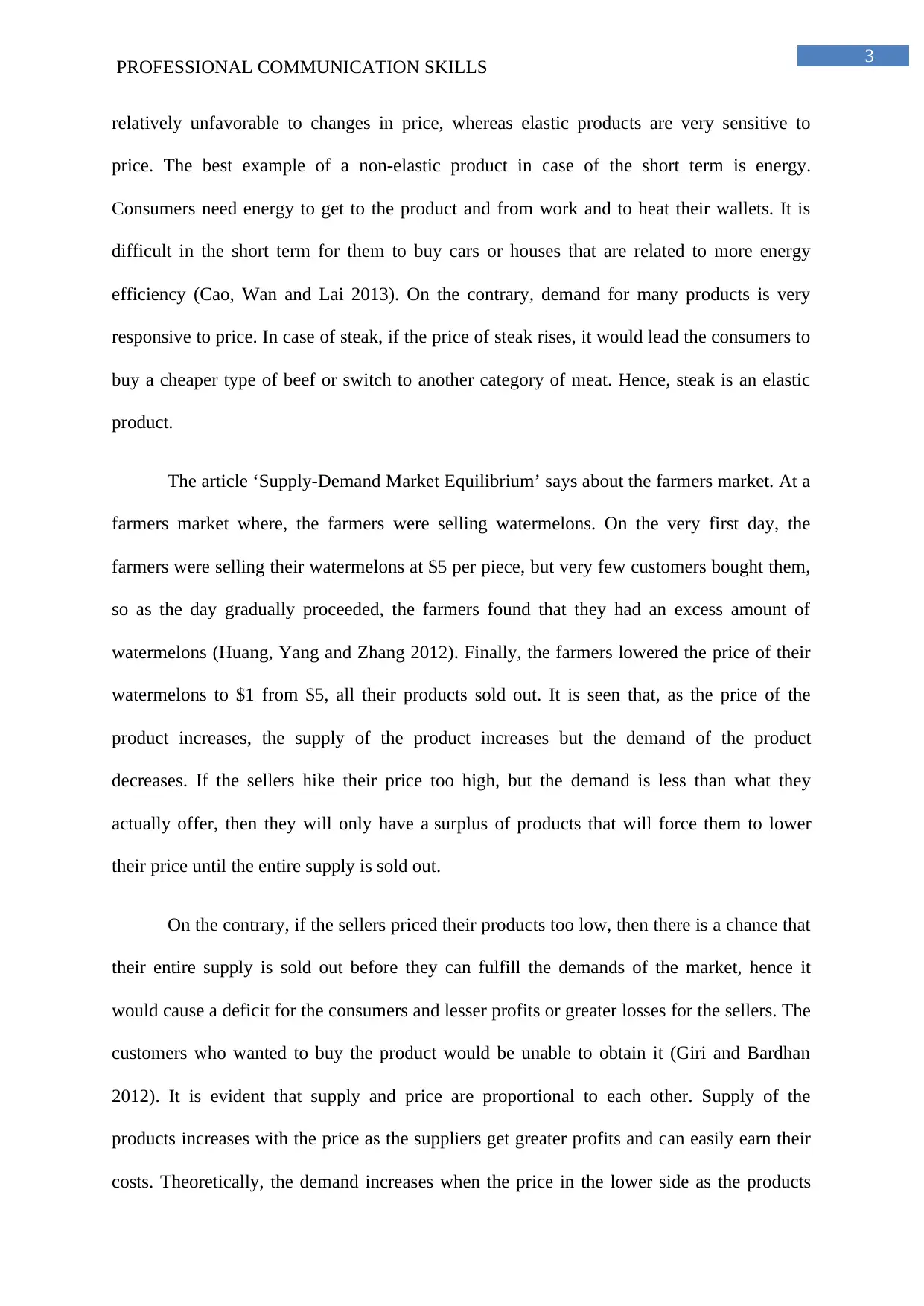
3
PROFESSIONAL COMMUNICATION SKILLS
relatively unfavorable to changes in price, whereas elastic products are very sensitive to
price. The best example of a non-elastic product in case of the short term is energy.
Consumers need energy to get to the product and from work and to heat their wallets. It is
difficult in the short term for them to buy cars or houses that are related to more energy
efficiency (Cao, Wan and Lai 2013). On the contrary, demand for many products is very
responsive to price. In case of steak, if the price of steak rises, it would lead the consumers to
buy a cheaper type of beef or switch to another category of meat. Hence, steak is an elastic
product.
The article ‘Supply-Demand Market Equilibrium’ says about the farmers market. At a
farmers market where, the farmers were selling watermelons. On the very first day, the
farmers were selling their watermelons at $5 per piece, but very few customers bought them,
so as the day gradually proceeded, the farmers found that they had an excess amount of
watermelons (Huang, Yang and Zhang 2012). Finally, the farmers lowered the price of their
watermelons to $1 from $5, all their products sold out. It is seen that, as the price of the
product increases, the supply of the product increases but the demand of the product
decreases. If the sellers hike their price too high, but the demand is less than what they
actually offer, then they will only have a surplus of products that will force them to lower
their price until the entire supply is sold out.
On the contrary, if the sellers priced their products too low, then there is a chance that
their entire supply is sold out before they can fulfill the demands of the market, hence it
would cause a deficit for the consumers and lesser profits or greater losses for the sellers. The
customers who wanted to buy the product would be unable to obtain it (Giri and Bardhan
2012). It is evident that supply and price are proportional to each other. Supply of the
products increases with the price as the suppliers get greater profits and can easily earn their
costs. Theoretically, the demand increases when the price in the lower side as the products
PROFESSIONAL COMMUNICATION SKILLS
relatively unfavorable to changes in price, whereas elastic products are very sensitive to
price. The best example of a non-elastic product in case of the short term is energy.
Consumers need energy to get to the product and from work and to heat their wallets. It is
difficult in the short term for them to buy cars or houses that are related to more energy
efficiency (Cao, Wan and Lai 2013). On the contrary, demand for many products is very
responsive to price. In case of steak, if the price of steak rises, it would lead the consumers to
buy a cheaper type of beef or switch to another category of meat. Hence, steak is an elastic
product.
The article ‘Supply-Demand Market Equilibrium’ says about the farmers market. At a
farmers market where, the farmers were selling watermelons. On the very first day, the
farmers were selling their watermelons at $5 per piece, but very few customers bought them,
so as the day gradually proceeded, the farmers found that they had an excess amount of
watermelons (Huang, Yang and Zhang 2012). Finally, the farmers lowered the price of their
watermelons to $1 from $5, all their products sold out. It is seen that, as the price of the
product increases, the supply of the product increases but the demand of the product
decreases. If the sellers hike their price too high, but the demand is less than what they
actually offer, then they will only have a surplus of products that will force them to lower
their price until the entire supply is sold out.
On the contrary, if the sellers priced their products too low, then there is a chance that
their entire supply is sold out before they can fulfill the demands of the market, hence it
would cause a deficit for the consumers and lesser profits or greater losses for the sellers. The
customers who wanted to buy the product would be unable to obtain it (Giri and Bardhan
2012). It is evident that supply and price are proportional to each other. Supply of the
products increases with the price as the suppliers get greater profits and can easily earn their
costs. Theoretically, the demand increases when the price in the lower side as the products
Paraphrase This Document
Need a fresh take? Get an instant paraphrase of this document with our AI Paraphraser
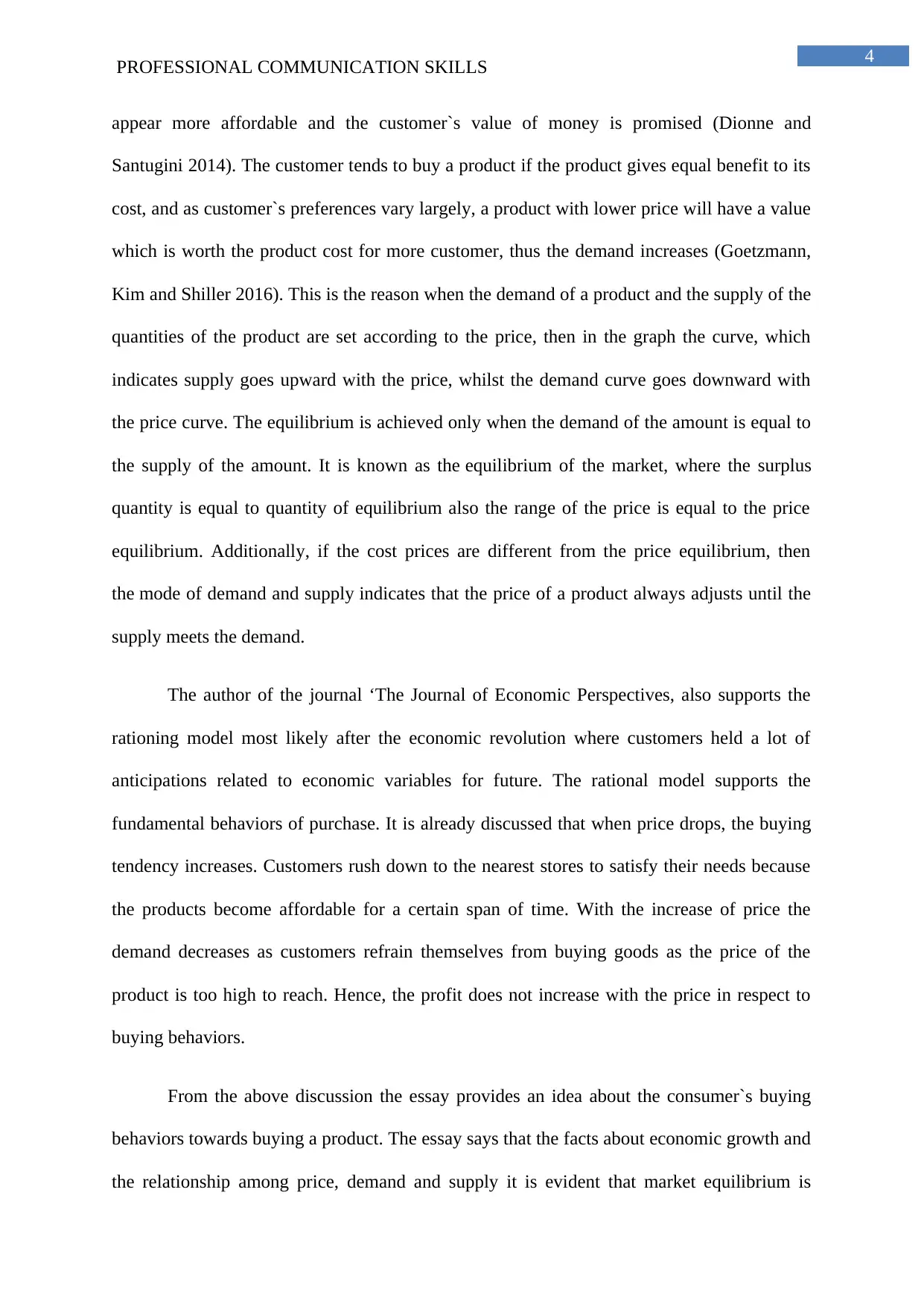
4
PROFESSIONAL COMMUNICATION SKILLS
appear more affordable and the customer`s value of money is promised (Dionne and
Santugini 2014). The customer tends to buy a product if the product gives equal benefit to its
cost, and as customer`s preferences vary largely, a product with lower price will have a value
which is worth the product cost for more customer, thus the demand increases (Goetzmann,
Kim and Shiller 2016). This is the reason when the demand of a product and the supply of the
quantities of the product are set according to the price, then in the graph the curve, which
indicates supply goes upward with the price, whilst the demand curve goes downward with
the price curve. The equilibrium is achieved only when the demand of the amount is equal to
the supply of the amount. It is known as the equilibrium of the market, where the surplus
quantity is equal to quantity of equilibrium also the range of the price is equal to the price
equilibrium. Additionally, if the cost prices are different from the price equilibrium, then
the mode of demand and supply indicates that the price of a product always adjusts until the
supply meets the demand.
The author of the journal ‘The Journal of Economic Perspectives, also supports the
rationing model most likely after the economic revolution where customers held a lot of
anticipations related to economic variables for future. The rational model supports the
fundamental behaviors of purchase. It is already discussed that when price drops, the buying
tendency increases. Customers rush down to the nearest stores to satisfy their needs because
the products become affordable for a certain span of time. With the increase of price the
demand decreases as customers refrain themselves from buying goods as the price of the
product is too high to reach. Hence, the profit does not increase with the price in respect to
buying behaviors.
From the above discussion the essay provides an idea about the consumer`s buying
behaviors towards buying a product. The essay says that the facts about economic growth and
the relationship among price, demand and supply it is evident that market equilibrium is
PROFESSIONAL COMMUNICATION SKILLS
appear more affordable and the customer`s value of money is promised (Dionne and
Santugini 2014). The customer tends to buy a product if the product gives equal benefit to its
cost, and as customer`s preferences vary largely, a product with lower price will have a value
which is worth the product cost for more customer, thus the demand increases (Goetzmann,
Kim and Shiller 2016). This is the reason when the demand of a product and the supply of the
quantities of the product are set according to the price, then in the graph the curve, which
indicates supply goes upward with the price, whilst the demand curve goes downward with
the price curve. The equilibrium is achieved only when the demand of the amount is equal to
the supply of the amount. It is known as the equilibrium of the market, where the surplus
quantity is equal to quantity of equilibrium also the range of the price is equal to the price
equilibrium. Additionally, if the cost prices are different from the price equilibrium, then
the mode of demand and supply indicates that the price of a product always adjusts until the
supply meets the demand.
The author of the journal ‘The Journal of Economic Perspectives, also supports the
rationing model most likely after the economic revolution where customers held a lot of
anticipations related to economic variables for future. The rational model supports the
fundamental behaviors of purchase. It is already discussed that when price drops, the buying
tendency increases. Customers rush down to the nearest stores to satisfy their needs because
the products become affordable for a certain span of time. With the increase of price the
demand decreases as customers refrain themselves from buying goods as the price of the
product is too high to reach. Hence, the profit does not increase with the price in respect to
buying behaviors.
From the above discussion the essay provides an idea about the consumer`s buying
behaviors towards buying a product. The essay says that the facts about economic growth and
the relationship among price, demand and supply it is evident that market equilibrium is
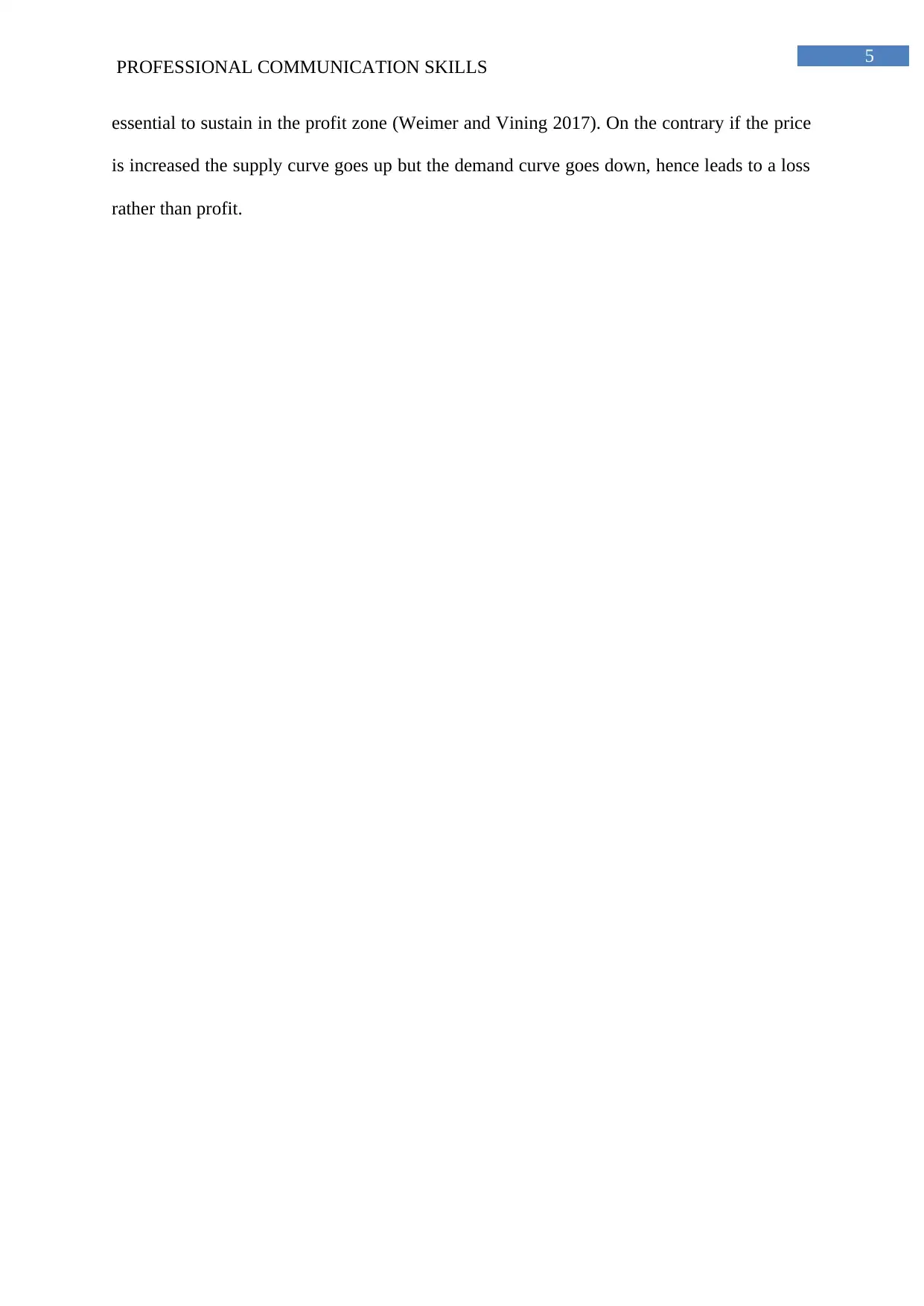
5
PROFESSIONAL COMMUNICATION SKILLS
essential to sustain in the profit zone (Weimer and Vining 2017). On the contrary if the price
is increased the supply curve goes up but the demand curve goes down, hence leads to a loss
rather than profit.
PROFESSIONAL COMMUNICATION SKILLS
essential to sustain in the profit zone (Weimer and Vining 2017). On the contrary if the price
is increased the supply curve goes up but the demand curve goes down, hence leads to a loss
rather than profit.
⊘ This is a preview!⊘
Do you want full access?
Subscribe today to unlock all pages.

Trusted by 1+ million students worldwide
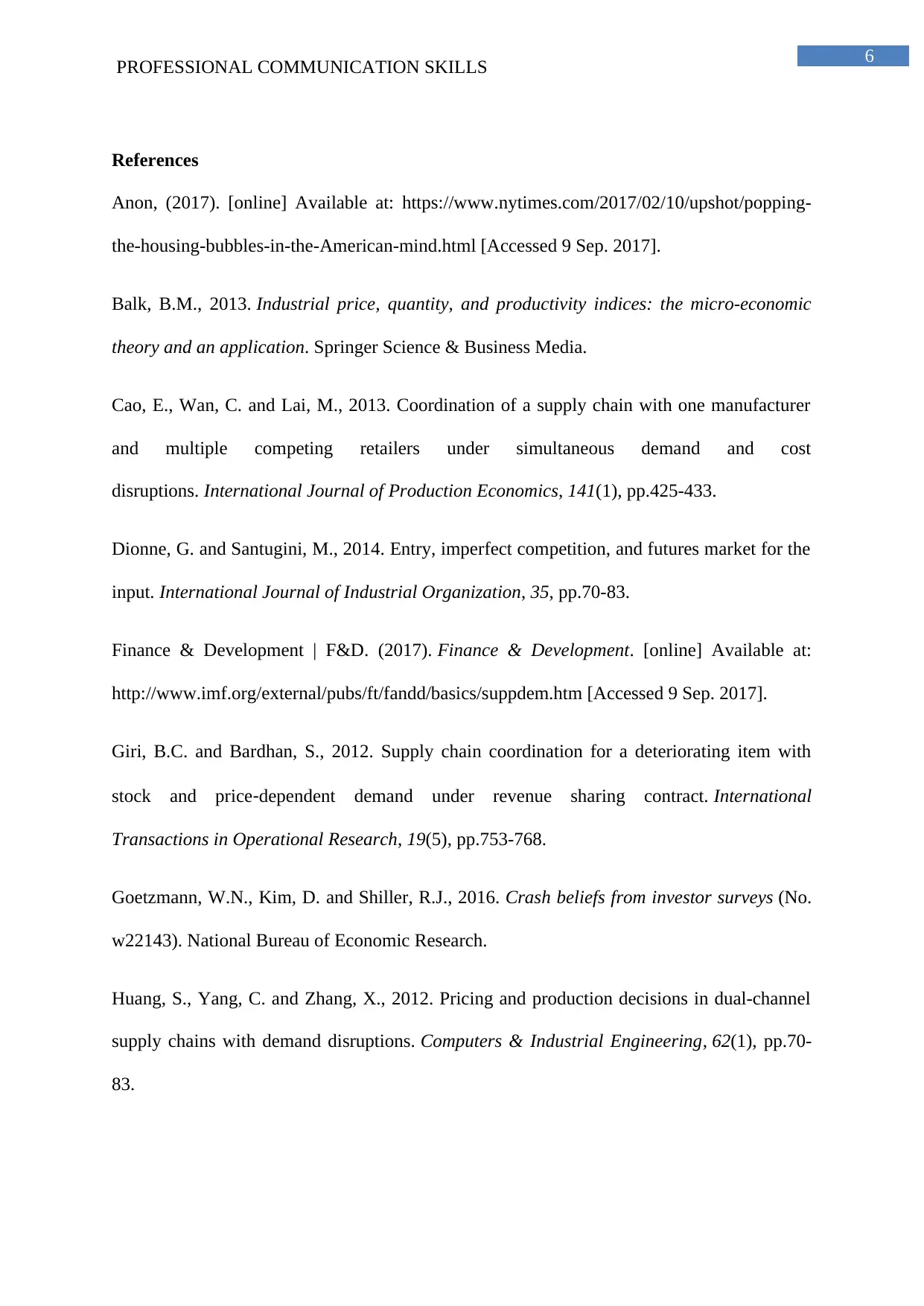
6
PROFESSIONAL COMMUNICATION SKILLS
References
Anon, (2017). [online] Available at: https://www.nytimes.com/2017/02/10/upshot/popping-
the-housing-bubbles-in-the-American-mind.html [Accessed 9 Sep. 2017].
Balk, B.M., 2013. Industrial price, quantity, and productivity indices: the micro-economic
theory and an application. Springer Science & Business Media.
Cao, E., Wan, C. and Lai, M., 2013. Coordination of a supply chain with one manufacturer
and multiple competing retailers under simultaneous demand and cost
disruptions. International Journal of Production Economics, 141(1), pp.425-433.
Dionne, G. and Santugini, M., 2014. Entry, imperfect competition, and futures market for the
input. International Journal of Industrial Organization, 35, pp.70-83.
Finance & Development | F&D. (2017). Finance & Development. [online] Available at:
http://www.imf.org/external/pubs/ft/fandd/basics/suppdem.htm [Accessed 9 Sep. 2017].
Giri, B.C. and Bardhan, S., 2012. Supply chain coordination for a deteriorating item with
stock and price‐dependent demand under revenue sharing contract. International
Transactions in Operational Research, 19(5), pp.753-768.
Goetzmann, W.N., Kim, D. and Shiller, R.J., 2016. Crash beliefs from investor surveys (No.
w22143). National Bureau of Economic Research.
Huang, S., Yang, C. and Zhang, X., 2012. Pricing and production decisions in dual-channel
supply chains with demand disruptions. Computers & Industrial Engineering, 62(1), pp.70-
83.
PROFESSIONAL COMMUNICATION SKILLS
References
Anon, (2017). [online] Available at: https://www.nytimes.com/2017/02/10/upshot/popping-
the-housing-bubbles-in-the-American-mind.html [Accessed 9 Sep. 2017].
Balk, B.M., 2013. Industrial price, quantity, and productivity indices: the micro-economic
theory and an application. Springer Science & Business Media.
Cao, E., Wan, C. and Lai, M., 2013. Coordination of a supply chain with one manufacturer
and multiple competing retailers under simultaneous demand and cost
disruptions. International Journal of Production Economics, 141(1), pp.425-433.
Dionne, G. and Santugini, M., 2014. Entry, imperfect competition, and futures market for the
input. International Journal of Industrial Organization, 35, pp.70-83.
Finance & Development | F&D. (2017). Finance & Development. [online] Available at:
http://www.imf.org/external/pubs/ft/fandd/basics/suppdem.htm [Accessed 9 Sep. 2017].
Giri, B.C. and Bardhan, S., 2012. Supply chain coordination for a deteriorating item with
stock and price‐dependent demand under revenue sharing contract. International
Transactions in Operational Research, 19(5), pp.753-768.
Goetzmann, W.N., Kim, D. and Shiller, R.J., 2016. Crash beliefs from investor surveys (No.
w22143). National Bureau of Economic Research.
Huang, S., Yang, C. and Zhang, X., 2012. Pricing and production decisions in dual-channel
supply chains with demand disruptions. Computers & Industrial Engineering, 62(1), pp.70-
83.
Paraphrase This Document
Need a fresh take? Get an instant paraphrase of this document with our AI Paraphraser
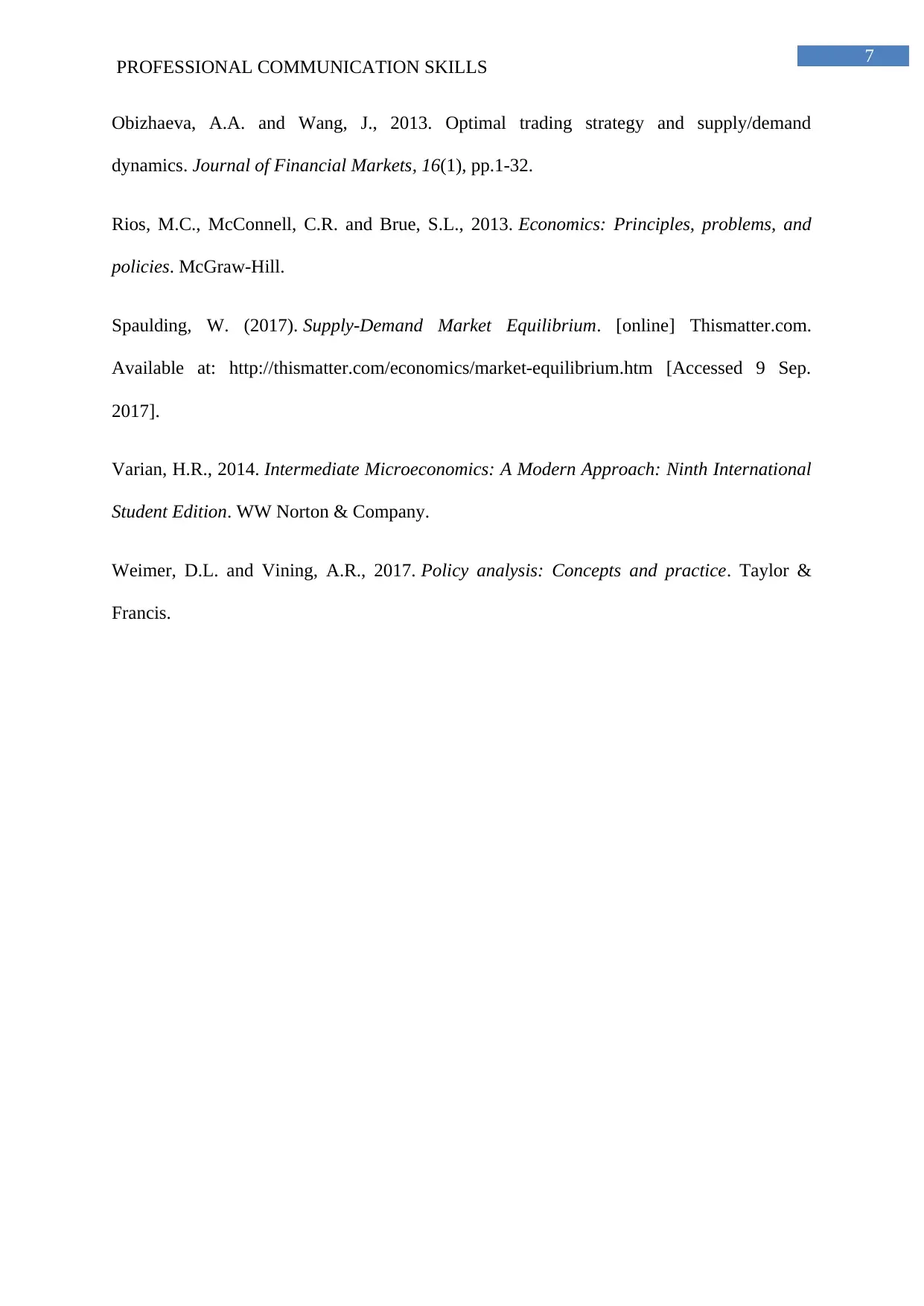
7
PROFESSIONAL COMMUNICATION SKILLS
Obizhaeva, A.A. and Wang, J., 2013. Optimal trading strategy and supply/demand
dynamics. Journal of Financial Markets, 16(1), pp.1-32.
Rios, M.C., McConnell, C.R. and Brue, S.L., 2013. Economics: Principles, problems, and
policies. McGraw-Hill.
Spaulding, W. (2017). Supply-Demand Market Equilibrium. [online] Thismatter.com.
Available at: http://thismatter.com/economics/market-equilibrium.htm [Accessed 9 Sep.
2017].
Varian, H.R., 2014. Intermediate Microeconomics: A Modern Approach: Ninth International
Student Edition. WW Norton & Company.
Weimer, D.L. and Vining, A.R., 2017. Policy analysis: Concepts and practice. Taylor &
Francis.
PROFESSIONAL COMMUNICATION SKILLS
Obizhaeva, A.A. and Wang, J., 2013. Optimal trading strategy and supply/demand
dynamics. Journal of Financial Markets, 16(1), pp.1-32.
Rios, M.C., McConnell, C.R. and Brue, S.L., 2013. Economics: Principles, problems, and
policies. McGraw-Hill.
Spaulding, W. (2017). Supply-Demand Market Equilibrium. [online] Thismatter.com.
Available at: http://thismatter.com/economics/market-equilibrium.htm [Accessed 9 Sep.
2017].
Varian, H.R., 2014. Intermediate Microeconomics: A Modern Approach: Ninth International
Student Edition. WW Norton & Company.
Weimer, D.L. and Vining, A.R., 2017. Policy analysis: Concepts and practice. Taylor &
Francis.
1 out of 8
Related Documents
Your All-in-One AI-Powered Toolkit for Academic Success.
+13062052269
info@desklib.com
Available 24*7 on WhatsApp / Email
![[object Object]](/_next/static/media/star-bottom.7253800d.svg)
Unlock your academic potential
Copyright © 2020–2025 A2Z Services. All Rights Reserved. Developed and managed by ZUCOL.



